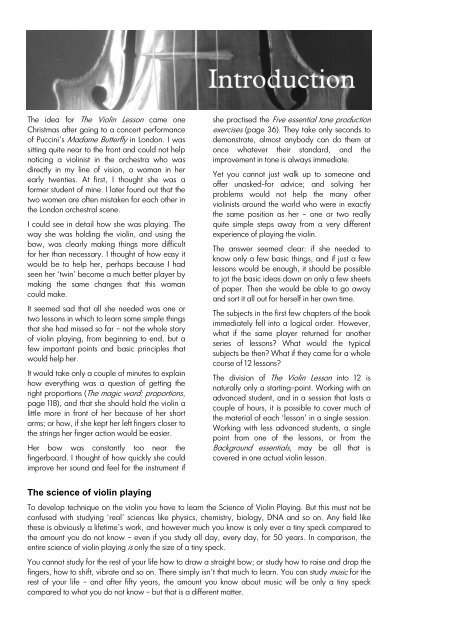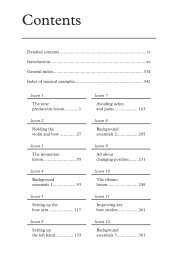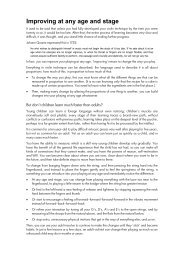Introduction (excerpt) - Simon Fischer
Introduction (excerpt) - Simon Fischer
Introduction (excerpt) - Simon Fischer
- No tags were found...
You also want an ePaper? Increase the reach of your titles
YUMPU automatically turns print PDFs into web optimized ePapers that Google loves.
The idea for The Violin Lesson came oneChristmas after going to a concert performanceof Puccini’s Madame Butterfly in London. I wassitting quite near to the front and could not helpnoticing a violinist in the orchestra who wasdirectly in my line of vision, a woman in herearly twenties. At first, I thought she was aformer student of mine. I later found out that thetwo women are often mistaken for each other inthe London orchestral scene.I could see in detail how she was playing. Theway she was holding the violin, and using thebow, was clearly making things more difficultfor her than necessary. I thought of how easy itwould be to help her, perhaps because I hadseen her ‘twin’ become a much better player bymaking the same changes that this womancould make.It seemed sad that all she needed was one ortwo lessons in which to learn some simple thingsthat she had missed so far – not the whole storyof violin playing, from beginning to end, but afew important points and basic principles thatwould help her.It would take only a couple of minutes to explainhow everything was a question of getting theright proportions (The magic word: proportions,page 118), and that she should hold the violin alittle more in front of her because of her shortarms; or how, if she kept her left fingers closer tothe strings her finger action would be easier.Her bow was constantly too near thefingerboard. I thought of how quickly she couldimprove her sound and feel for the instrument ifshe practised the Five essential tone productionexercises (page 36). They take only seconds todemonstrate, almost anybody can do them atonce whatever their standard, and theimprovement in tone is always immediate.Yet you cannot just walk up to someone andoffer unasked-for advice; and solving herproblems would not help the many otherviolinists around the world who were in exactlythe same position as her – one or two reallyquite simple steps away from a very differentexperience of playing the violin.The answer seemed clear: if she needed toknow only a few basic things, and if just a fewlessons would be enough, it should be possibleto jot the basic ideas down on only a few sheetsof paper. Then she would be able to go awayand sort it all out for herself in her own time.The subjects in the first few chapters of the bookimmediately fell into a logical order. However,what if the same player returned for anotherseries of lessons? What would the typicalsubjects be then? What if they came for a wholecourse of 12 lessons?The division of The Violin Lesson into 12 isnaturally only a starting-point. Working with anadvanced student, and in a session that lasts acouple of hours, it is possible to cover much ofthe material of each ‘lesson’ in a single session.Working with less advanced students, a singlepoint from one of the lessons, or from theBackground essentials, may be all that iscovered in one actual violin lesson.The science of violin playingTo develop technique on the violin you have to learn the Science of Violin Playing. But this must not beconfused with studying ‘real’ sciences like physics, chemistry, biology, DNA and so on. Any field likethese is obviously a lifetime’s work, and however much you know is only ever a tiny speck compared tothe amount you do not know – even if you study all day, every day, for 50 years. In comparison, theentire science of violin playing is only the size of a tiny speck.You cannot study for the rest of your life how to draw a straight bow; or study how to raise and drop thefingers, how to shift, vibrate and so on. There simply isn’t that much to learn. You can study music for therest of your life – and after fifty years, the amount you know about music will be only a tiny speckcompared to what you do not know – but that is a different matter.
On a practical, physical level of violin technique, there is not so much to know about. There are all thethings you have got to learn to do; and all the things to learn not to do. Yet all this amounts to only a fewprinciples about how to hold the instrument and bow, how to use each hand in all the various ways, andso on. The list of ‘things you need to know and do’ is not endless, and is not even very long.The Violin Lesson covers the main areas where you can easily and noticeably make a difference. Whilenot every subject is for everyone, The Violin Lesson has something in it for every level and type of player –elementary or advanced, amateur or professional, teacher or student.Can you improve your playing by reading a book?No book can replace a teacher or the living, practical experience of playing or listening to music. Butgaining information from a book, or gaining that information through having somebody listen to you playand then saying those same things to you, can often be the same thing in the end.If you want to change the way you play the violin, you have to change the way you think about playingthe violin. You can do that by practising or by going to a concert, and by many other means; but readingabout, say, tone production, can so change your picture of bowing the string that your whole approachchanges immediately and dramatically – even before you have actually put the bow on the string andstarted to try things out.Q But the points in a book can only be general ones. In a lesson the teacher deals with your specific,individual needs.Everyone has their own unique set of physical, technical and musical characteristics, their own particulargifts, problems, strengths and weaknesses; yet the same technical and musical points tend to appearagain and again, and in the same way, in most players.Typical technical points in the left arm include freeing the thumb; moving the fingers freely from thebase joints, without partly moving them from the hand or forearm; widening the hand at the basejoints, rather than contracting; fingers remaining light without over-pressing; co-ordination, and thefundamentals of vibrato, intonation, shifting and so on.Typical technical points in the right arm include the basics of how to make a pure and expressivetone; fundamentals of the bow hold; the mechanics of drawing a straight bow; how to improve keystrokes like spiccato or martelé, and so on.There are actually quite a limited number of technical problems that you can have, and they tend to cropup in the same ways all the time. So the topics and issues that are explored in The Violin Lesson mayeasily be exactly those that you need to explore yourself.Suppose your left hand does not feel comfortable. You do not necessarily need someone to look at whatyou, specifically, are doing, and make suggestions that are tailored only to you. The same principles aregoing to apply to you as to anyone else.Building a good left hand position, or strengthening intonation, or developing tone or vibrato, or gainingconfidence in shifting, is almost entirely the same process whoever you are, and whatever your age orstandard.Q What about different ‘schools’ of playing? How do I know what is right for me? Is it not best to stick towhat my teacher tells me, to avoid any contradiction or confusion?There have been many different approaches to technique around the world, and from age to age,usually stemming from, or based around, one particular player’s or teacher’s approach. Different schoolsof playing favour certain distinctive bow holds, or certain approaches to tone or vibrato. However, allthe different approaches are united by natural laws and principles.These natural laws of cause-and-effect, proportion, leverage and balance, must apply whatever theapproach or philosophy of playing, so there should be no danger of contradiction.Q What is an example, in practical violin terms, of a ‘law’ that must apply whatever the school ofplaying?How far away from the thumb should the first finger sit on the bow?
The laws of leverage dictate that the further away the first finger is from the thumb, the more effect it hasin adding to the weight of the bow into the string; the closer to the thumb you place the first finger, themore it needs to do to achieve the same result. 1There may be different ways of holding the bow, but this principle of leverage must apply, in exactly thesame way, whether you are a violinist in New York, Moscow, London or Tokyo.1 See First finger:leverage, page 64






